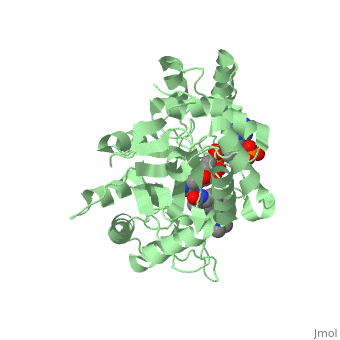Sandbox 45673
From Proteopedia
(Difference between revisions)
| Line 20: | Line 20: | ||
==Medical== | ==Medical== | ||
| - | Finasteride is used to shrink an enlarged prostate, also known as benign prostatic hyperplasia (BPH), in adult men. This medication works by | + | Finasteride is used to shrink an enlarged prostate, also known as benign prostatic hyperplasia (BPH), in adult men (Allen, 2015). Enlarged prostate is located near the bladder which causes difficulty with passing urine. Common symptoms include, long period of time before urine flow, feeling the bladder is not empty, and dribbling urine (Allen, 2015). This medication works by blocking the enzyme 5a-reductase, which prevents conversion of testosterone to the natural body hormone, dihydrosestosterone (DHT) that causes growth of the prostate. As a result, reducing the amount of dihydrotestosterone causes the prostate to shrink. Thus, helps the urine pass easily. |
Finasteride can also lead to improvements in Androgenetic alopecia, male pattern baldness (MPB), which is caused by an androgen-dependent miniaturization of scalp hair follicles. Testosterone is the major flow of androgen, but to be maximally active in scalp hair follicles it must be converted to dihydrotestosterone (DHT) by the enzyme 5a- reductase. DHT is an important factor in MPB by the absence of the condition in males with a insufficiency of type II 5a-reductase, and by small amounts of hair regrowth in men with MPB (Olsen, et al., 2006). Finasteride acts as an inhibitor for the type II 5a-reductase enzyme, which has shown to reduce both serum and scalp skin dihydrotestosterone levels in balding men (Leyden, et al., 1999). Side effects from Finasteride include but are not limited to, decreased sexual ability and desire. | Finasteride can also lead to improvements in Androgenetic alopecia, male pattern baldness (MPB), which is caused by an androgen-dependent miniaturization of scalp hair follicles. Testosterone is the major flow of androgen, but to be maximally active in scalp hair follicles it must be converted to dihydrotestosterone (DHT) by the enzyme 5a- reductase. DHT is an important factor in MPB by the absence of the condition in males with a insufficiency of type II 5a-reductase, and by small amounts of hair regrowth in men with MPB (Olsen, et al., 2006). Finasteride acts as an inhibitor for the type II 5a-reductase enzyme, which has shown to reduce both serum and scalp skin dihydrotestosterone levels in balding men (Leyden, et al., 1999). Side effects from Finasteride include but are not limited to, decreased sexual ability and desire. | ||
Revision as of 00:44, 17 November 2016
N-(1,1-dimethylethyl)-3-oxo-(5α,17β)-4-azaandrost-1-ene-17-carboxamide
| |||||||||||

